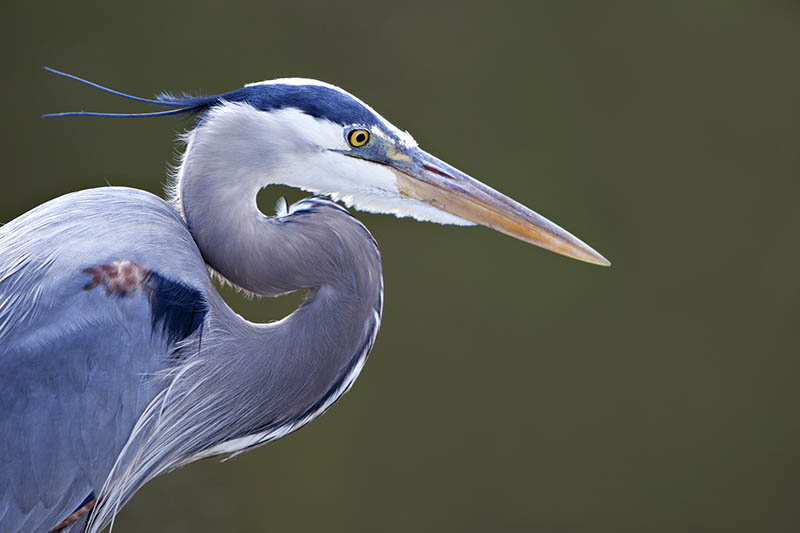Do Great Blue Herons Migrate? Everything You Need to Know
Last Updated on

Ardea Herodias, or the blue heron, is a magnificent heron that calls much of North America and even some areas of Central America Home. You can find these birds wading and foraging for food in coastal environments and freshwater habitats. However, they will often nest in more secluded wooded swamps or islands for safety from prey.
Whether or not a blue heron migrates depends entirely on where they live. This is referred to as a partially migratory bird. Many birds that live in the northern parts of the world will migrate south during the winter, and this is true for the blue heron in most of the provinces in Canada. But the British Columbian coast and parts of Newfoundland and Labrador are home to the blue heron year-round.

Blue Heron Migration Timing
The blue heron typically begins to migrate south when the cooler weather rolls in from mid-September to late October. This timing is usually a little later in the Canadian provinces, Alberta and Ontario. Many of the herons don’t leave until November or December.
Depending on where a blue heron is returning to, they will migrate north and arrive at their nesting grounds anywhere from March to mid-May. Warm weather is not the deciding factor of when the birds return as they are fairly hardy birds, fully capable of living in cooler weather.

Where Does a Blue Heron Stay?
As mentioned above, the blue heron stays year-round on the British Columbia coasts and parts of Newfoundland and Labrador. In addition, much of the United States is home to these birds year-round. The exception to this is some of the north central states.
How Far Does a Blue Heron Go?
There is no real one-size-fits-all answer to how far the blue heron migrates. Some of these birds will only travel a few hundred miles to escape the winter weather at the northern parts of their breeding grounds. While other blue herons could potentially travel thousands of miles from Canada down to Mexico or Central America.
Purpose of a Blue Heron Migrating
One reason for migration, like most birds, is the weather. Although a blue heron is well-equipped to endure winter, it’s not their most ideal living condition. The primary reason that a blue heron migrates is due to food availability. Because their diet consists mainly of marine life or other critters living near the water, freezing water during the winter threatens their food supply.
If the freezing season is relatively short, some brave blue herons will feed on non-marine creatures like mice until the ice thaws. This can be risky and sometimes results in death for the bird.

Do Blue Herons Migrate Alone or in Groups?
This depends on the situation. Some blue herons have been known to migrate alone or in groups of three to 12. But some migration groups have reached up to 100 birds, all flying south together.
The reason migration groups are typically so small with blue herons is because they are not overly social birds. They need a lot of food, so they usually stick to themselves or stay in small groups. The only real exception is during mating season—sometimes, they will gather into colonies of hundreds of birds to find mates in an elaborate mating ritual.
Blue Heron Nesting
Typically, blue herons begin nesting as soon as they reach their nesting grounds in the Spring. The male heron begins gathering materials for the female to incorporate into the nest. This process usually takes the birds around a week to complete.
Once the nest is built, the female will lay three to five eggs on average. Baby heron survival is based on food availability. If there are any food shortages, only the strongest birds survive to repeat the migratory process at the end of the nesting season. The new heron will leave the nest permanently at around 10 weeks.

Conclusion
Many species of birds either migrate or don’t. So, it’s interesting when we’re looking at a species like the blue heron, whose migration is dependent on where it lives because they have such a vast range. Essentially if a blue heron has suitable access to food year-round, it will stay. Otherwise, they will migrate south—potentially for thousands of miles.
Featured Image Credit: Mary Rice, Shutterstock
About the Author Shea Cummings
Shea Cummings is a passionate content writer who believes that the power of words is immeasurable. He leverages years of experience in various trades such as carpentry, photography, and electrical to bring his articles to life. His goal is to provide his readers with information that delights and informs. When he's not writing you can find him spending time in the outdoors or playing some Minecraft on the Xbox with his wife and two sons.
Related Articles:
10 Types of Hummingbirds in Arkansas (With Pictures)
8 Types of Hummingbirds in Nebraska (With Pictures)
5 Types of Hummingbirds in Idaho (With Pictures)
3 Types of Hummingbirds in Mississippi (With Pictures)
8 Types of Hummingbirds in Kansas (With Pictures)
5 Types of Hummingbirds in West Virginia (With Pictures)
5 Types of Hummingbirds in Ohio (With Pictures)
Where Do Nuthatches Nest? Nuthatch Nesting Habits Explained
